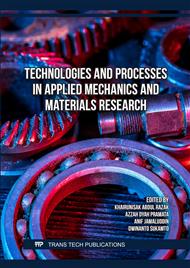[1]
H. Ritchie and M. Roser, "CO₂ and Greenhouse Gas Emissions," Our World in Data CO2 and Greenhouse Gas Emissions, 2017. https://ourworldindata.org/co2-and-other-greenhouse-gas-emissions.
DOI: 10.1787/eco_surveys-lva-2017-graph68-en
Google Scholar
[2]
US Environmental Protection Agency, "Inventory of U.S. Greenhouse Gas Emissions and Sinks: 1990–2019," United Nations Framew. Conv. Clim. Chang., 2021.
Google Scholar
[3]
R. Durth, "Sustainable maritime shipping and climate action," KfW Res., no. 279, 2020.
Google Scholar
[4]
R. Lu and J. W. Ringsberg, "Ship energy performance study of three wind-assisted ship propulsion technologies including a parametric study of the Flettner rotor technology," Ships Offshore Struct., vol. 15, no. 3, p.249–258, 2020.
DOI: 10.1080/17445302.2019.1612544
Google Scholar
[5]
T. Chou, V. Kosmas, M. Acciaro, and K. Renken, "A comeback of wind power in shipping: An economic and operational review on thewind-assisted ship propulsion technology," Sustain., vol. 13, no. 4, p.1–16, 2021.
DOI: 10.3390/su13041880
Google Scholar
[6]
M. F. Pradana, F. A. Ichsan, and B. Noche, "The pathway to decarbonization : Flettner rotor application in maritime logistics," 2021.
DOI: 10.2991/aer.k.220131.012
Google Scholar
[7]
J. Siegl, I. S. Arief, and A. R. Hartawan, "Analysis of Energy Efficiency of Rotate Flettner Rotor Based on Variation in Wind Direction and Rotor's Material," Int. J. Mar. Eng. Innov. Res., vol. 5, no. 2, p.92–101, 2020.
DOI: 10.12962/j25481479.v5i2.5713
Google Scholar
[8]
E. E-ship, "Enercon E-Ship 1," 2013, no. September, p.23–24.
Google Scholar
[9]
I. S. Seddiek and N. R. Ammar, "Harnessing wind energy on merchant ships: case study Flettner rotors onboard bulk carriers," Environ. Sci. Pollut. Res.,2021.
DOI: 10.1007/s11356-021-12791-3
Google Scholar
[10]
Norsepower, "Passenger vessel of Norsepower." https://www.norsepower.com/passenger (accessed Oct. 11, 2021).
Google Scholar
[11]
A. B. Comer et al., "Rotors and bubbles : Route-based assessment of innovative technologies to reduce ship fuel consumption and emissions," 2019.
Google Scholar
[12]
S. Brett, "Muskets and pendulums: Benjamin Robins, Leonhard Euler, and the ballistics revolution," Technol. Cult., vol. 35, no. 2, p.348–382, 1994.
DOI: 10.1353/tech.1994.0084
Google Scholar
[13]
C. Badalamenti and S. A. Prince, "The Effects of Endplates on a Rotating Cylinder in Crossflow," no. August, p.1–17, 2008.
DOI: 10.2514/6.2008-7063
Google Scholar
[14]
A. De Marco, S. Mancini, C. Pensa, G. Calise, and F. De Luca, "Flettner Rotor Concept for Marine Applications: A Systematic Study," Int. J. Rotating Mach., vol. 2016, 2016.
DOI: 10.1155/2016/3458750
Google Scholar
[15]
M. Traut et al., "Propulsive power contribution of a kite and a Flettner rotor on selected shipping routes," Appl. Energy, vol. 113, p.362–372, 2014.
DOI: 10.1016/j.apenergy.2013.07.026
Google Scholar
[16]
I. N. Brown and M. F. Aldridge, "Power Models and Average Ship Parameter Effects on Marine Emissions Inventories," J Air Waste Manag Assoc., no. 215, p.200001, 2012.
DOI: 10.1080/10962247.2019.1580229
Google Scholar
[17]
G. Mirko, V. Medica, and G. Radica, "Calculation of Efficiencies of a Ship Power Plant Operating with Waste Heat Recovery through Combined Heat and Power Production," p.4273–4299, 2015.
DOI: 10.3390/en8054273
Google Scholar
[18]
J. Faber and Et al, "Fourth IMO Greenhouse Gas Study," 2021.
Google Scholar
[19]
I. S. Arief, A. Santoso, and A. Azzam, "Design of Flettner Rotor in Container Carrier 4000 DWT with CFD Method," Int. J. Mar. Eng. Innov. Res., vol. 2, no. 2, p.2–8, 2018.
DOI: 10.12962/j25481479.v2i2.2736
Google Scholar



